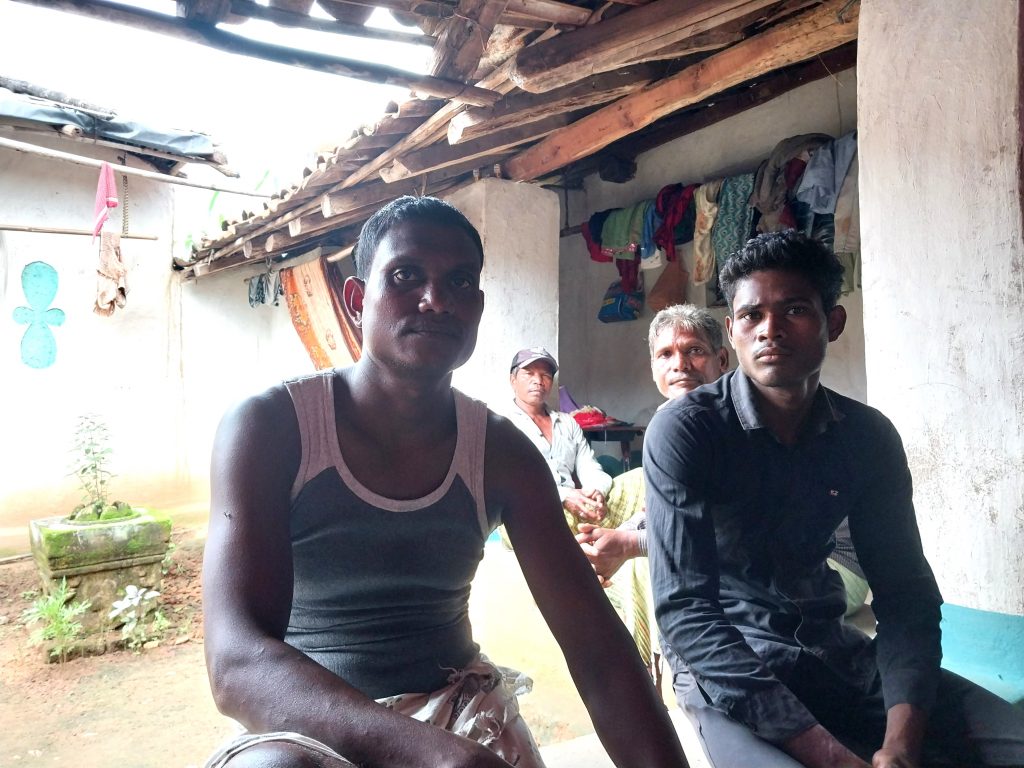
For a successful conservation programme, there is a need for an inclusive policy for locals and need to understand their issues. But on many occasions both these attributes have been found lacking in the conservation drives, writes Deepanwita Gita Niyogi
In the dense forest of Chhattisgarh’s Achanakmar Tiger Reserve, a five-and-a-half years-old tigress has been keeping trackers on toes ever since its release on April 28 this year. The animal’s release, and possibly of three more towards the end of this year or early next, has expedited talks of relocation which has been hanging in the air for years.
In Barighat, there are some 13 households. Rituraj Baiga remains unfazed. As the Baiga village lies in the buffer range, it may not be shifted. But life is hard. Residents depend on solar stand posts for lighting homes and charging mobile phones. They do not own agricultural lands.
Barighat’s residents are either employed in casual labour or sell bamboo items, the most common being the jhaua, used for carrying soil. It is sold to traders at Rs 40 per piece.
Sonuram Baiga, in his 20s, travels eight km up and down daily. He slogs for hours on others’ fields during sowing and harvesting. In exchange, the young man receives 28 kg rice and Rs 3,000 monthly. He also does odd jobs for the forest department which ensures income of Rs 355 daily. Sonuram’s family has been living in Barighat for six generations.
The Achanakmar Tiger Reserve, which shares a border with Kanha, has only five tigers according to the Status of Tigers, Co-Predators and Prey in India census report 2022. The April release is part of its tiger recovery plan. The reserve has 19 villages. One of its biggest villages is Achanakamar which has a few shops, roadside hotels, school and a primary health centre. Though talks about relocation is a hot topic here, it is not on the radar. Villages Birarpani, Tilaidabra and Chhirhatta lying in the core will be relocated.
Conservation and displacement
In India, mining and developmental projects have historically displaced forest-dwelling communities. Social justice also eludes them in the name of forest protection and wildlife conservation, especially tiger conservation.
The country launched Project Tiger in 1973 to augment the species’ falling population. Over the years though tiger conservation has been hailed as an achievement, communities living inside tiger reserves have suffered due to restrictions put on them. India currently has 3682 tigers. From just nine tiger reserves in the 1970s, there are 54 now.
According to cricketer-turned-conservationist Saad Bin Jung, once the British took over, protection laws were enacted and communities no longer remained keepers of forests. “After Independence, the Indian government retained the exclusionary laws of the British. Conservation was more or less defined as protection of the environment. There has been zero effort to take along people.”
As India plans to increase tiger numbers for tourism, more displacement is possible in future. Conservationists argue relocation of villages is the only way out to minimise human-animal conflict which is high in many places.
Leading tiger expert Ullas Karanth pointed out that in many key habitats, forest dwellers are volunteering to relocate if adequate welfare facilities are created. In reality, the issue is complex. Often, post displacement, people get poor quality lands and lose access to livelihood based on forest wealth.
To go or not to go
Of the 25 villages inside Achanakmar tiger reserve, six were resettled 20-30 km away in 2010. The old cash compensation package of Rs 10 lakh has been revised to Rs 15 lakh to make it more attractive. Those willing to get land can settle for two hectares. The relocation of three villages will gain momentum after the assembly polls scheduled in November.

People, however, are divided on the issue. Some feel leaving is best as facilities are denied. Bindawal’s Raju Singh said remaining close to one’s roots was a better option as stepping outside could give rise to problems. The village has a population of about 1200. But Anjor Singh was quick to point out frequent crop damage by wild animals. He owns 3.75 acres of land.
The lure of livelihood often pushes people outside. One of Anjor Singh’s sons went to Bengaluru for two months to work as a helper to a juice shop seller. But he returned after being cheated of his payment.
Though many residents of Bindawal consented to relocate a decade back, the process is stuck. “Those who left in 2010 have concrete houses. Some of us want to leave right away but the residents of those villages where we want to settle down aren’t giving their consent,” added Singh, who loses almost half of his produce of 75 quintals of paddy due to crop depredation.
There are other problems too. Young Manisha Siyam said that establishing marriage connections is a problem with outsiders unwilling to step here. In Chhaparwa village, Ram Singh Baiga informed that though villagers placed requests for pucca houses under the Indira Awas Yojana, a housing scheme for the rural poor, it has yet not been fulfilled. Now, that tigers are being released, living here will be difficult, he admitted. People are already plagued by elephants.
Rakli Baiga’s LPG connection is of no use. The refill station is far and the condition of the road is bad, especially in monsoon. Firewood collection is scary with elephants roaming the jungle.

“When elephants raided last year, my family stayed up the night on the roof of the pucca house built under the Indira Awas Yojana,” Santu Yadav of Bindawal village reminisced. Yadav was lucky to have it five years back for permission has been stalled for new ones.
Forest life vs outside
Andhiyar Baiga and his wife Sukhri are residents of Tilaidabra village which is on the relocation radar. They own two miniscule land plots and depend on the forest for livelihood. “The department told us to stay on guard inside the forest because of the tigress. We came to know after it was released. But I am afraid of elephants too,” said the man who collects mushrooms and sells bamboo brooms at Rs 10-12 per piece.
A Chhattisgarh forest officer, not wishing to be named, explained people living inside forests form a connection with nature. Settling down outside servers that and comes as a shock for many. He feels that the way out is to make communities aware. But often there is a communication gap, people aren’t consulted beforehand and only when conflicts arise, forest officials approach communities. But by then it is too late.

It is true that many people want to lead a better life outside, replete with facilities. In Achanakmar’s Katami village, forest guard Ravi Siyam said though there are obstacles in the path of relocation, many want to leave. In his village, to avail emergency health services, residents have to go elsewhere, the nearest being Bamni, two km away. Siyam said last year during the monsoon, an elderly woman died due to snake bite while being taken across the Maniyari river which overflows in monsoon.
It is being hoped Achanakmar Tiger Reserve will turn things around for Chhattisgarh where tiger count has dwindled from 46 in 2014 to 17 at present. But for a successful conservation programme, there is a need for an inclusive policy for locals, feels chief conservator of forests P Kathirvel of Rajasthan, where the new Dholpur-Karauli Tiger Reserve has been recently announced, sparking off the displacement debate.
Kathirvel admitted conflict in Ranthambore Tiger Reserve where the government is trying to provide arms to forest guards. “It was not an issue before, but now many are turning against us. Cattle roam the forest and when the staff try to prevent them from grazing, confrontation occurs. Locals are our stakeholders in conservation. There is a need to understand their issues. Many lack other sources of income.”

In Achanakmar Tiger Reserve, the landless are willing to relocate. Meena Bai’s modest roadside hotel which serves tea and breakfast has seen a setback over the years. Her daily income has come down to Rs 300-400 from Rs 1500-2000. It is because a few buses plying inside the reserve do not halt at Achanakmar, her village. They stop for a minute at the check post and move on.
Life is hard for women who venture inside jungles for firewood. Perhaps that is the reason why in Chhaparwa village, a few women are willing to opt for the cash package and move out. “None of us wants land as we don’t have any. If we stay back, we may die of hunger. The tiger reserve has made life unbearable. Pucca houses are not permitted and the patchy road is not repaired,” said Rekha Sakat.
Cash package seems safe as going for land is tricky. After displacement, the residents of Bahaud, one of the six villages relocated earlier, received infertile land. They have been betrayed, the women told in unison.
Raipur-based wildlife activist Nitin Singhvi said in Achanakmar Tiger Reserve, all the 19 villages were supposed to be shifted by 2020 but that did not happen. Now, he fears that some degree of development has taken place which may act as a deterrent. There are already pucca houses. Piped water supply under the Jal Jeevan Mission has also been established.
While it is true that India’s tiger turnaround happened due to conservation activism, Karanth said it happened before activism became fashionable recently. Conservation is considered vexatious, often ignoring people.
Conservationist and wildlife historian Raza Kazmi said it would be wrong to say conservation activism does not take people into account. “Conservationists of the new generation care about people. One could argue that until the early 2000s, conservation activism did not focus much on community-related issues. However, that has undergone a radical shift. Conservationists have realized that without taking into account the aspirations of communities, conservation does not work in the long run.”
Achanakmar is gearing up to receive more tigers either from Maharashtra or Madhya Pradesh following an approval from the National Tiger Conservation Authority. The tigress released in April in a core range is doing well.
(The story has been covered under the Narender Revelli National Media Fellowship 2023 administered by Turaga Foundation and the Department of Communication, University of Hyderabad.)













